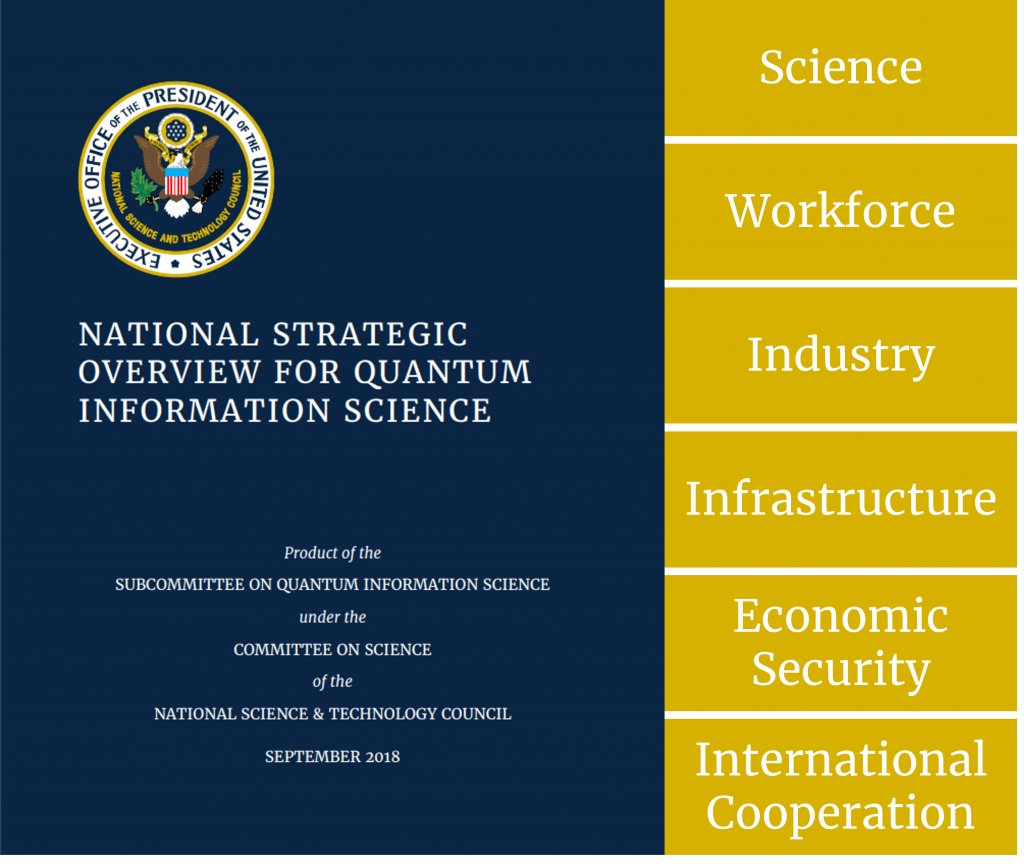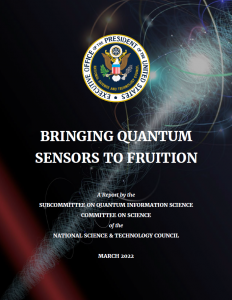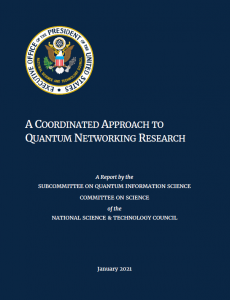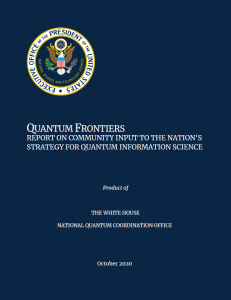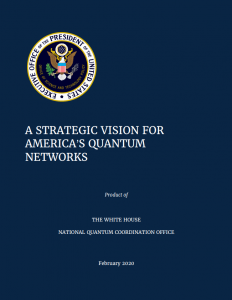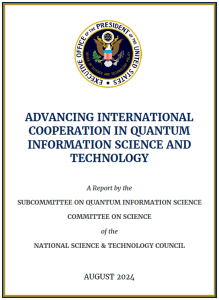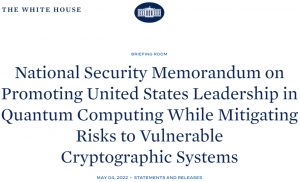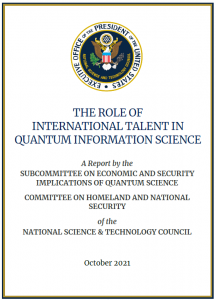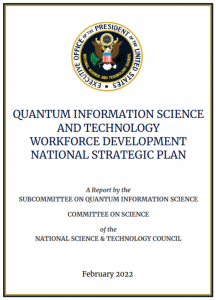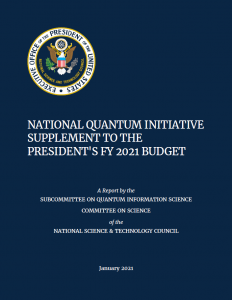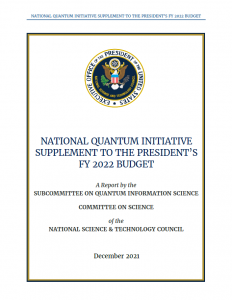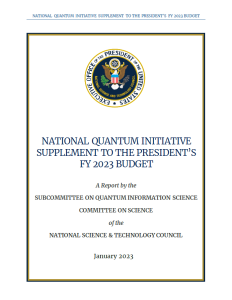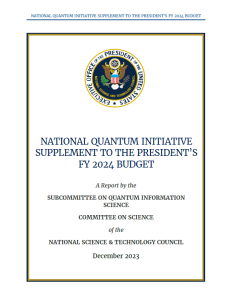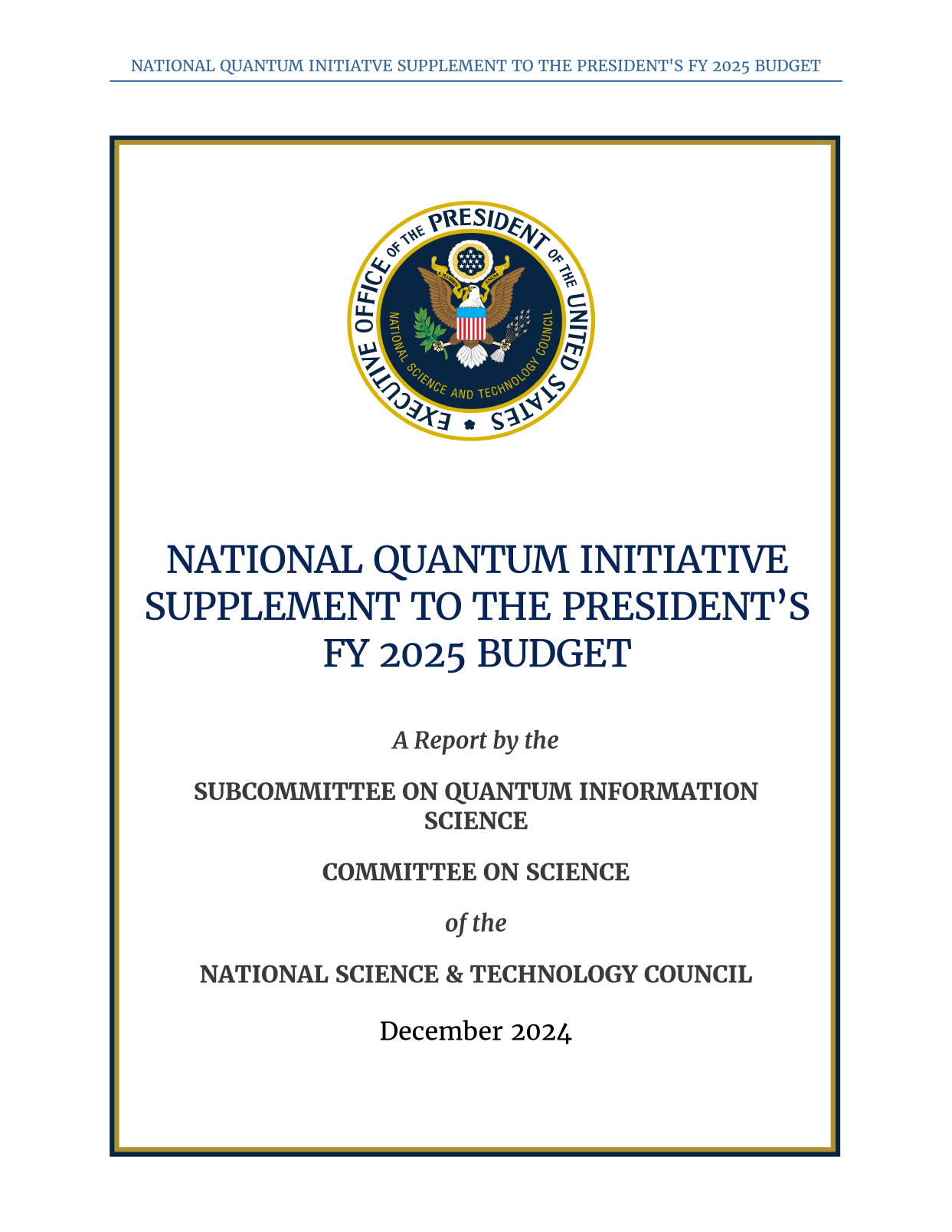STRATEGIC OVERVIEW
The 2018 NSTC report, “A National Strategic Overview for Quantum Information Science,” set the Nation’s strategy for ensuring continued leadership in quantum information science. The strategy contains six areas of policy (science, workforce, industry, infrastructure, economic security, and international cooperation), but they can be summarized in three sentences:
- Getting the science right by understanding the applications and timelines by which QIS will benefit society, and the roadblocks we must overcome to get there.
- Enhancing competitiveness by accelerating technology development toward useful economic and mission applications of QIS and working with international partners, while also protecting national security.
- Enabling people by building the necessary talent pathways and ensuring that QIS creates new opportunities for all Americans.
For activities supporting these areas, please click the links below:
STRATEGY DOCUMENTS
Since the release of the 2018 National Strategic Overview for Quantum Information Science, several documents have been released that augment the national quantum strategy. Below, they are grouped according to the broad categories of science documents, competitiveness and security documents, and workforce documents.
SCIENCE
Bringing Quantum Sensors to Fruition
Quantum sensors can offer improved accuracy, stability, sensitivity, and precision over traditional technologies. The realization of new quantum sensors is a tangible, near-term objective of the National Quantum Initiative. This document recommends four actions that U.S. Departments and Agencies can take to coordinate research and development and facilitate fruitful applications of quantum sensor technologies:
- Agencies leading QIST R&D should accelerate the development of new quantum sensing approaches and prioritize appropriate partnerships with end users to elevate the technology readiness of new quantum sensors.
- Agencies that use sensors should conduct feasibility studies and jointly test quantum prototypes with QIST R&D leaders to identify promising technologies and to focus on quantum sensors that address their agency mission.
- Agencies that support engineering R&D should develop broadly applicable components and subsystems, such as compact reliable lasers and integrated optics, to facilitate the development of quantum technologies and promote economies of scale.
- Agencies should streamline technology transfer and acquisition practices to encourage the development and early adoption of quantum sensor technologies.
A Coordinated Approach to Quantum Networking
A coordinated approach to quantum networking research that leverages the unique strengths of several Federal agencies will accelerate the science and engineering necessary to develop useful quantum network components and applications. Recognizing the growing number of significant efforts on quantum networking research, this report recommends actions Federal agencies can take together to advance the Nation’s knowledge base and readiness to utilize quantum networks. Its four technical recommendations are:
- Continue Research on Use Cases for Quantum Networks
- Prioritize Cross-Beneficial Core Components for Quantum Networks
- Improve Classical Capabilities to Support Quantum Networks
- Leverage “Right-Sized” Quantum Networking Testbeds
The report also includes three programmatic recommendations:
- Increase Interagency Coordination on Quantum Networking R&D
- Establish Timetables for Quantum Networking R&D Infrastructure
- Facilitate International Cooperation on Quantum Networking R&D
Quantum Frontiers
Quantum Frontiers are areas to explore where solutions to grand challenges can lead to transformative advances in quantum information science, engineering, and technology. With input from the QIS R&D community, the NQCO identified eight quantum frontiers:
- Expanding Opportunities for Quantum Technologies to Benefit Society
- Building the Discipline of Quantum Engineering
- Targeting Materials Science for Quantum Technologies
- Exploring Quantum Mechanics through Quantum Simulations
- Harnessing Quantum Information Technology for Precision Measurements
- Generating and Distributing Quantum Entanglement for New Applications
- Characterizing and Mitigating Quantum Errors
- Understanding the Universe through Quantum Information
These are elaborated upon in the Quantum Frontiers Report which cites community responses to the public request for information regarding the National Strategic Overview for QIS. Also cited are three dozen scientific and technical reports from federally funded QIS workshops, roundtables, and studies. These reports can be found in the quantum.gov publication library here.
A Strategic Vision for America’s Quantum Networks
Quantum computing and networking technologies are still at an early stage of research and development (R&D). The strategic vision focuses America’s R&D efforts to advance the development of foundations for the quantum internet. It establishes QIS community goals for quantum networking, and recommends six specific technical areas for focused research activity.
This strategic vision is driven by the National Quantum Initiative Act, signed into law by President Trump in December 2018, to accelerate QIS R&D through increased federal investment and coordination. The strategy was developed through the NQIA’s coordinating bodies, the National Quantum Coordination Office and the National Science and Technology Council’s Subcommittee on Quantum Information Science and reflects deep community input from SCQIS request for information responses of 2018-2019 and from workshops hosted by Federal agencies.
COMPETITIVENESS
Advancing International Cooperation in Quantum Information Science and Technology Report
International cooperation is a vital component of the U.S. strategy for QIS. It accelerates innovation, facilitates robust access to supply chains and markets, and guides the development of QIST-related principles, policies, and effective practices in the international community. This report makes recommendations for the U.S. Government to address an overarching goal of enabling international cooperation in QIST that imparts mutual benefits and that prioritizes shared values, scientific purpose, and economic promise. The recommendations are:
- The U.S. Government should create dedicated and long-term mechanisms to fund international QIST collaboration and cooperation.
- Agencies should enhance interagency coordination of international cooperation practices to reinforce an integrated U.S. Government-wide portfolio for international QIST engagement.
- The U.S. Government should establish and track metrics for global competitiveness across QIST topics and enabling technologies.
National Security Memorandum on Quantum-Resistant Cryptography
On May 4, 2022, the President signed National Security Memorandum 10, National Security Memorandum on Promoting United States Leadership in Quantum Computing While Mitigating Risks to Vulnerable Cryptographic Systems. It outlines the Administration’s policy toward quantum computing, gives strategies to promote the emerging technology, prioritizes mitigating risks to encryption, and ensures protection of intellectual property:
- Overview: Quantum computing holds the potential to drive innovations across the American economy, yet it also poses significant risks to the economic and national security of the United States. To balance these, it is the policy of the United States (1) to maintain United States leadership in QIS; and (2) transition to quantum-resistant cryptography in a timely and equitable manner.
- Promoting quantum innovation: The United States should continue to pursue a whole-of-government strategy to harness the benefits of QIS, garner security enhancements provided by quantum-resistant cryptography, encourage transformative and fundamental scientific discoveries through investments in core QIS research programs, seek to foster the next generation of scientists and engineers with quantum-relevant skill sets, and promote domestic partnerships and professional and academic collaborations with overseas allies and partners.
- Mitigating cybersecurity risks: The timely and equitable transition of cryptographic systems to quantum-resistant encryption must be prioritized. Central to this effort will be an emphasis on cryptographic agility, to reduce the transition time and to allow for updates for future cryptographic standards. A series of deadlines for federal agencies to support the transition was established.
- Protecting sensitive technology: The U.S. Government must work to safeguard relevant quantum R&D and intellectual property (IP) and to protect relevant enabling technologies and materials. Agencies responsible for either promoting or protecting quantum technologies should understand the security implications. U.S. should ensure the protection of U.S. developed quantum technologies from theft by our adversaries.
The Role of International Talent in Quantum Information Science Report
This report highlights the critical role that international talent plays in ensuring a vibrant and successful U.S. research enterprise in QIST, including the importance of close collaboration with foreign partners, while also stressing the importance of protecting the technology and expertise of the United States and our international partners. It finds that maintaining a strong flow of international students and researchers is an essential component to developing the expert QIST workforce required to achieve U.S. QIST goals as part of an advancing global research enterprise. The report makes four policy recommendations:
- The United States should continue to develop and support policies that welcome talented individuals from all over the world, while implementing appropriately balanced protections that mitigate potential research security concerns.
- Federal organizations should engage in close collaboration with allies and partners to ensure a vibrant and secure international QIST ecosystem that is underpinned by shared values and principles, including freedom of inquiry, merit-based competition, openness and transparency, accountability, and reciprocity.
- The National Quantum Coordination Office and NSTC Subcommittee on Quantum Information Science should augment the National Strategic Overview for Quantum Information Science with a strategic plan for QIST workforce development. A five-year plan should assess evolving and future workforce needs, grow the domestic pool of talent, and foster ways to attract and retain top QIST talent from around the world.
- Federal organizations that fund research, development, and acquisition of QIST should develop coordinated, comprehensive technology protection plans to safeguard intellectual capital and property, while accounting for specific mission needs. These measures should address current and evolving methods used to target U.S. technology, while promoting U.S. ideals of open and transparent R&D.
PEOPLE
QIST Workforce Development National Strategic Plan
Workforce development in Quantum Information Science and Technology (QIST) is a priority for the United States as part of the National Quantum Initiative. To ensure economic and national security, several actions are recommended here to evaluate the QIST workforce landscape, prepare more people for jobs with quantum technology, enhance STEM education at all levels, accelerate exploration of quantum frontiers, and expand the talent pool for industries of the future. The document identifies four critical actions:
- Develop and maintain an understanding of the workforce needs in the QIST ecosystem,
with both short-term and long-term perspectives. - Introduce broader audiences to QIST through public outreach and educational materials.
- Address QIST-specific gaps in professional education and training opportunities.
- Make careers in QIST and related fields more accessible.
ANNUAL REPORTS
As legislated in Section 103(g) of the National Quantum Initiative Act, the NSTC Subcommittee on Quantum Information Science shall submit an annual program budget report containing the budget for the National Quantum Initiative Program for the current fiscal year and next fiscal year, as well as “analysis of the progress made toward achieving the goals and priorities” of the Program. Pursuant to this mandate, the annual reports produced so far are posted below:
PUBLICATION LIBRARY
Strategy documents, annual reports, event summaries, and scientific and technical reports can be found in the Publication Library.


